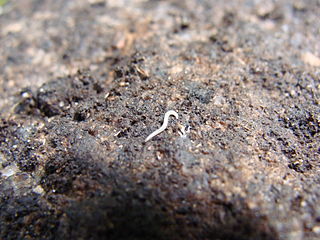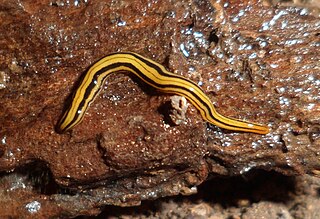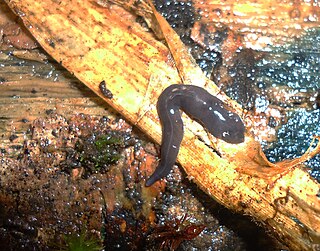
Microplaninae is a subfamily of land planarians.

Geoplaninae is a subfamily of land planarians endemic to the Neotropical region. Members of this family are sometimes referred to as the Neotropical land planarians. However, one species, Obama nungara has been introduced in Europe.

Luteostriata is a genus of land planarians from Brazil characterized by a yellow body with dark longitudinal stripes.

Obama is a genus of land planarians from South America. It contains several species adapted to human-disturbed environments, including the only invasive land planarian native to the Neotropical realm, Obama nungara, which has been accidentally introduced in Europe.

Paraba is a genus of land planarians from South America.

Cratera is a genus of land planarians found in South America.

Pasipha is a genus of land planarians from South America.

Notogynaphallia is a genus of land planarians from South America.

Issoca is a genus of land planarians from Brazil.

Barreirana is a genus of land planarians from Brazil, formerly considered a subgenus of Geoplana.
Eudóxia Maria Froehlich was a Brazilian zoologist.

Amaga is a genus of land planarians from South America.

Bogga is a genus of land planarians from South America. It is monotypic, being represented by the single species, Bogga bogotensis, which occurs in Bogotá, Colombia.

Luteostriata abundans is a species of Brazilian land planarian in the subfamily Geoplaninae. It is a common species in human-disturbed areas in Brazil's southernmost state, Rio Grande do Sul.

Luteostriata graffi is a species of Brazilian land planarian in the subfamily Geoplaninae.

Luteostriata ernesti is a species of Brazilian land planarian in the subfamily Geoplaninae.
Timyma is a genus of land planarians from Chile. It is the sole genus of the subfamily Timyminae.
Novibipalium is a genus of land planarians of the subfamily Bipaliinae.

Geoplanini is a tribe of land planarians in the subfamily Geoplaninae.

Choeradoplana claudioi is a species of land planarian belonging to the subfamily Geoplaninae. It is known from specimens found in the Augusto Ruschi Biological Reserve in Brazil.
















